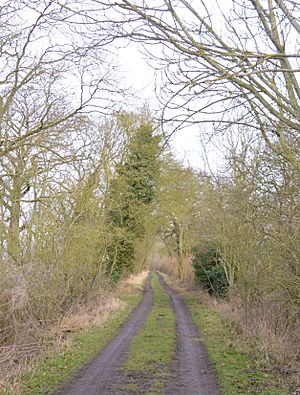Hayley Wood facts for kids
| Site of Special Scientific Interest | |
 |
|
| Area of Search | Cambridgeshire |
|---|---|
| Interest | Biological |
| Area | 51.7 hectares |
| Notification | 1984 |
| Location map | Magic Map |
Hayley Wood is a special forest in Cambridgeshire, England. It covers about 51.7 hectares, which is like 128 football fields! This area is protected because it's a very important place for nature. It's called a Site of Special Scientific Interest (SSSI) because of its amazing plants and animals. The Wildlife Trust for Bedfordshire, Cambridgeshire and Northamptonshire helps to look after it. A famous expert on woodlands, Oliver Rackham, even wrote a book about Hayley Wood.
Contents
A Look Back in Time: The History of Hayley Wood
Hayley Wood has a long and interesting past. It was first mentioned way back in 1086 in the Domesday Book. This was a huge survey ordered by William the Conqueror to record everything in England! Back then, it was part of a bigger forest.
Over time, the large forest split into two parts: Hayley Wood and Littlehound Wood. By 1251, Hayley Wood was about 40 acres. After 1350, farming in the area slowed down. This allowed the forest to grow bigger! By 1650, Hayley Wood had expanded to about 120 acres. Sadly, Littlehound Wood was cleared for farming around 1655, but you can still see its old shape in the field lines today.
In 1579, Queen Elizabeth I took Hayley Wood from the Bishop of Ely, and it became privately owned.
The Railway Line
From 1863 to 1969, a railway line called the Varsity Line ran right along the northern edge of Hayley Wood. This railway connected the cities of Bedford and Cambridge. Even though the tracks are gone now, the old railway path is still special. Many beautiful flowers grow there, like the hairy violet and the clustered bellflower.
In 1962, Hayley Wood became the very first place bought by a new group. This group is now known as the Wildlife Trust for Bedfordshire, Cambridgeshire and Northamptonshire. They help protect nature in the area.
Where is Hayley Wood?
Hayley Wood is located in the south-east part of Little Gransden, a small area in Cambridgeshire. It's about 10 miles (17 km) south-west of the city of Cambridge. The soil in the wood is heavy clay. This means that when it rains, the flat top of the hill can get quite wet and muddy!
Amazing Plants and Animals
Hayley Wood is home to many different kinds of plants and trees. The forest has a special structure called "coppice-with-standards." This means there are smaller trees and bushes that are cut back regularly (coppiced). Taller trees, called "standards," are left to grow tall.
Trees and Shrubs
You'll find trees like field maple, ash, hazel, and hawthorn growing here. Above them, a canopy of tall pedunculate oak trees provides shade. There are also small areas of small-leaved elm. Many of the oak trees are very old, dating back to the late 1700s or early 1800s!
Wildflowers and Other Plants
The clay soil in Hayley Wood is perfect for certain wildflowers. It's famous for having one of the largest populations of oxlip flowers in Britain! You can also spot meadowsweet here. In drier spots, you'll see bluebells and yellow archangel.
Other plants that like ancient woodlands grow here too. These include wood anemone, dog's mercury, and early purple orchid. If you're lucky, you might even find the rare bird's-nest orchid or pale sedge.
How Hayley Wood is Cared For
The people who manage Hayley Wood use special methods to keep it healthy.
Coppicing
One important method is called coppicing. This is an old way of managing woodlands. People cut certain trees and bushes down to the ground. This makes them grow back with many new shoots. Coppicing has been done in Hayley Wood since at least the 1200s! It stopped for a while but started again in 1964.
Leaving dead wood on the ground is also important. It's a great home for tiny plants called liverworts and for birds like woodpeckers.
Keeping the Forest Healthy
The open paths and clearings in the wood are mowed regularly. This helps keep the soil from becoming too rich in nutrients, which allows a wider variety of plants to grow.
In 1972, a fence was put up around most of the wood. This fence helps keep deer out. Before the fence, deer were eating too many of the young oxlip plants. The fence has helped the oxlip population grow back stronger!
How to Visit Hayley Wood
You can get to Hayley Wood from the B1046 road by taking Hayley Lane.

